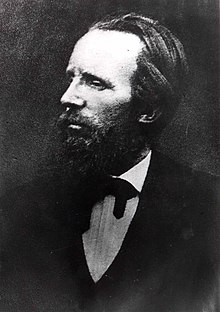Julius Bahnsen | |
|---|---|
 | |
| Born | 30 March 1830 |
| Died | 7 December 1881 (aged 51) |
| Era | 19th-century philosophy |
| Region | Western philosophy |
| School | |
Main interests | |
Notable ideas | |
Preview warning: Page using Template:Infobox philosopher with unknown parameter "influences"
Preview warning: Page using Template:Infobox philosopher with unknown parameter "influenced"
Julius Friedrich August Bahnsen (30 March 1830 – 7 December 1881) was a German philosopher. Bahnsen is usually considered the originator of characterology and a real-dialectical method of philosophical reflection which he laid down in his two-volume Contributions to Characterology (1867) and developed forth with his following works, amongst others his magnum opus The Contradiction in the Knowledge and Being of the World (1880/82).
- ^ Beiser, Frederick C., Weltschmerz: Pessimism in German Philosophy, 1860-1900, Oxford: Oxford University Press, 2016, p. 246.
- ^ Beiser, Frederick C., Weltschmerz: Pessimism in German Philosophy, 1860-1900, Oxford: Oxford University Press, 2016, p. 230.
- ^ Beiser, Frederick C., Weltschmerz: Pessimism in German Philosophy, 1860-1900, Oxford: Oxford University Press, 2016, p. 229.
- ^ Harry Slochower, Julius Bahnsen, Philosopher of Heroic Despair, 1830-1881, The Philosophical Review Vol. 41, No. 4 (Jul., 1932), pp. 368-384
- ^ Beiser, Frederick C., Weltschmerz: Pessimism in German Philosophy, 1860-1900, Oxford: Oxford University Press, 2016, p. 263.
- ^ Harry Slochower, Julius Bahnsen, Philosopher of Heroic Despair, 1830-1881, The Philosophical Review Vol. 41, No. 4 (Jul., 1932), pp. 368-384
- ^ Beiser, Frederick C., Weltschmerz: Pessimism in German Philosophy, 1860-1900, Oxford: Oxford University Press, 2016, p. 233.
- ^ Brobjer, Thomas. Nietzsche's Philosophical Context: An Intellectual Biography. University of Illinois Press, 2008. pp. 39, 48, 55, 140.
- ^ Jensen, Anthony. Julius Bahnsen's Influence on Nietzsche's Wills-Theory. Journal of Nietzsche Studies Vol. 47, No. 1 (Spring 2016). pp. 101–118.